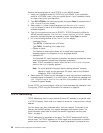
Note: For information about using a DNS server to manage entries, in place
of host tables, refer to 421.
7. Configuring local domain and host name
8. Starting TCP/IP
9. Verifying TCP/IP connection
10. Saving the TCP/IP configuration
Important Note:
To perform the configuration steps discussed throughout this chapter, you
need the special authority of *IOSYSCFG defined in your user profile.
Step 1—Configuring a Line Description
AS/400 TCP/IP supports various local area network (LAN) and wide area network
(WAN) connection types: Ethernet, token-ring, SDDI and FDDI, wireless LAN, X.25
SVC, and permanent virtual circuit (PVC), Async (for SLIP), Point-to-Point (PPP)
and frame relay. Refer to Appendix A. Configuring a Physical Line for TCP/IP
Communication for information about how to configure an Ethernet line for TCP/IP
communications.
These are the important parameters for configuring a line description:
v Line description name
v Resource name
v Local adapter address
v Ethernet standard
v Source service access point (SSAP) list.
The SSAP X'AA' required for an IEEE 802.3 Ethernet is automatically allocated if
you use the *SYSGEN special value.
When TCP/IP starts an interface, the line, controller, and device descriptions are
varied on automatically. If the controller and device descriptions for a line do not
exist, TCP/IP creates them automatically when it attempts to start an interface using
that line. This happens at TCP/IP startup time if the TCP/IP interface that is
associated with the newly configured line is set to AUTOSTART *YES.
Step 2—Configuring a TCP/IP Interface
In an AS/400 system, each line that connects to a TCP/IP network must be
assigned to at least one Internet address. You do this by configuring, or
adding
a
TCP/IP interface. The additional interfaces are logical interfaces, not physical ones.
These logical interfaces are associated with a line description.
An interface identifies a direct connection to a network using TCP/IP and a physical
medium (communications line). You must consider the following when defining an
interface:
Internet address
A 32-bit address assigned to hosts using TCP/IP. It is associated with the
line description.
30 OS/400 TCP/IP Configuration and Reference V4R4


















